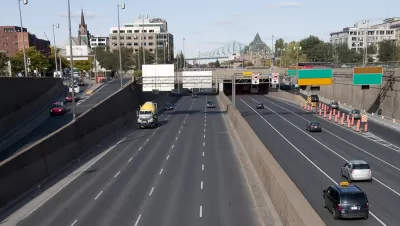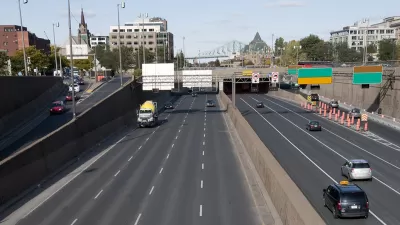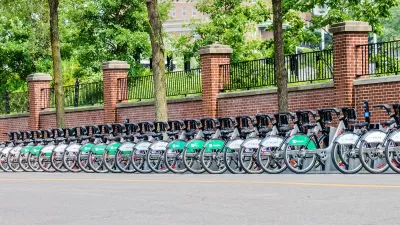Montreal will include one less elevated highway—so long Bonaventure Expressway.

Andy Riga reports: "Montreal started tearing down its portion of the elevated Bonaventure Expressway this week, promising to replace it with two boulevards with a series of green spaces between them, by September 2017."
The expressway is owned partly by Ottawa (between the Champlain Bridge and the Lachine Canal) and partly by Montreal (from the canal to downtown). The elevated expressway was serving about 25,000 drivers per day prior to being closed for demolition, according to Riga.
The two boulevards running parallel to the elevated expressway will be reconfigured to handle the traffic, though with two fewer lanes in total than the previous configuration. The city aims to make the changes without increasing congestion by implementing "an 'intelligent transportation system' that will let the city adjust the timing of traffic lights according to traffic conditions." A proposed light rail line would also connect downtown to the South Shore neighborhoods formerly served by the expressway.
Planetizen first reported on the proposed demolition of the Bonaventure Expressway in December 2014.
FULL STORY: Say goodbye to elevated stretch of Bonaventure Expressway

Manufactured Crisis: Losing the Nation’s Largest Source of Unsubsidized Affordable Housing
Manufactured housing communities have long been an affordable housing option for millions of people living in the U.S., but that affordability is disappearing rapidly. How did we get here?

Americans May Be Stuck — But Why?
Americans are moving a lot less than they once did, and that is a problem. While Yoni Applebaum, in his highly-publicized article Stuck, gets the reasons badly wrong, it's still important to ask: why are we moving so much less than before?

Using Old Oil and Gas Wells for Green Energy Storage
Penn State researchers have found that repurposing abandoned oil and gas wells for geothermal-assisted compressed-air energy storage can boost efficiency, reduce environmental risks, and support clean energy and job transitions.

What Forest Service Cuts Mean for Cities
U.S. Forest Service employees work on projects that have impacts far beyond remote, rural wilderness areas.

North Texas Transit Leaders Tout Benefits of TOD for Growing Region
At a summit focused on transit-oriented development, policymakers discussed how North Texas’ expanded light rail system can serve as a tool for economic growth.

Poorest NYC Neighborhoods Pay Price for Delivery Boom
The rise of ‘last-mile’ e-commerce warehouses — and their attendant truck traffic and air pollution — is disproportionately impacting the most historically disadvantaged parts of the city.
Urban Design for Planners 1: Software Tools
This six-course series explores essential urban design concepts using open source software and equips planners with the tools they need to participate fully in the urban design process.
Planning for Universal Design
Learn the tools for implementing Universal Design in planning regulations.
Heyer Gruel & Associates PA
City of Moreno Valley
Institute for Housing and Urban Development Studies (IHS)
City of Grandview
Harvard GSD Executive Education
Salt Lake City
NYU Wagner Graduate School of Public Service
City of Cambridge, Maryland





























